Introduction
Global warming and air pollution have become more and more serious in recent years, posing a great threat to people’s health, quality of life and ecological balance. An article from EEA in 2022 shows that 40 percent of principal anthropogenic greenhouse gases emissions comes from carbon dioxide from the road transportation of passengers and freight (EEA, 2020). Although more and more countries started paying attention to the global environment since the mid-20th Century, the problem of global pollution continues to grow. Therefore, vehicle pollution becomes the most urgent matter. Such a situation has led to great interest in electric cars. Ghosh (2020) concludes that BEVs are considered a true zero-emission vehicle when they are on the road due to the lack of tailpipe emissions compared to other types of cars, so they are treated as a best solution to global warming (Ghosh (2020)). However, there are some debates about EVs – the energy required to charge EVs comes from fossil fuels which still causes some pollution. The process of battery production will also consume a lot of energy and lead to land acidification, formation of particulate matter and many other problems. But as technology advances, electric cars are getting better and better. The most common battery used today
are lithium-ion batteries which have large density, strong endurance and long life which is cleaner and more Findings and Discussions
EVs are the best solution for global warming compared with hybrid electric vehicles (HEVs) and traditional internal combustion engine vehicles (ICEVs) through the whole life cycle., although EVs are zero-emission vehicles when they are on the road (figure 1).
However, it is hard to say that EVs are totally environment friendly since there are pollutions coming from the producing. Therefore, this article will not only focus on the emissions of electric vehicles on the road, but also pay attention to its entire life cycle
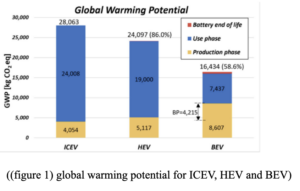
There is a method called Life Cycle Assessment (LCA) which will focus on five different environmental impact categories generated during all phases of the entire life of the vehicles, from raw material collection and parts production to vehicle assembly and on-road use, finishing hence with the disposal phase (Hauschild et al.,2011). There is a LCA study by Usai et al. (2021) confirmed that the carbon emissions will be reduced by up to 70% if the renewable energy sources are used. Because of the declining manufacturing costs and charging infrastructure development, Europe ranks second in the world in EVs sales (IEA, 2019). There are over 1.8 million “battery electric vehicle (BEV)”and “plug-in hybrid electric vehicle (PHEV)” sales in Europe in 2019(EEA,2020), so Europe canbe used as an example to study EVs. We will compare two extreme different electricity mix in two countries of Europe which is the Poland and the Norway. The electricity mix is a particular mix of energy sources used to generate electricity, which is different between countries (Pipitone et al.,2021). In Norway, the proportion of EVs is extremely high so there is almost no carbon footprint. However, in Poland, they are still dependent on fossil fuels. These cases have allowed extending the limits of the analysis, embracing all the European real possible scenarios.
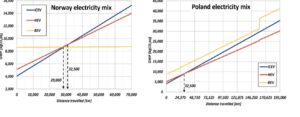
Figure 2 is the global warming impacts comparison as function of the lifetime traveled distance. GWP is global warming potential which expressed the equivalent mass of CO2 emitted when obtaining a product or a service (Pipitone et al.,2021). From the left graph of Norway, it shows that even EVs have higher GWP at the beginning which is 8500 gCO2eq/km. However, looking at the whole lifetime, the EVs GWP remains the same as the beginning which is much lower than ICEV and HEV after the 29000 km traveled. In the right graph of Poland, it shows that the BEV’s GWP is higher compared to the other countries obviously. Therefore, relying solely on fossil fuels, electric vehicles have a questionable impact on global warming. However, most countries have changed their electricity mix now, which is similar to Norway’s in that they use more clean or renewable energy. In this case, EV can indeed have a lower GWP to reduce environmental pollution.
Besides, EVs can help to solve the global warming since it can help to save non-renewable energy. A nonrenewable resource is a natural resource the amount of which on earth is finite and which has no natural regeneration process. (Groth, C.,2007) There are four major types of nonrenewable resources: oil, natural gas, coal, and nuclear energy. Oil, natural gas, and coal are collectively called fossil fuels. Raugei affirmed that the EV integration can reduce significantly the UK’s dependence on conventional primary energy sources (Raugei et al. 2018).
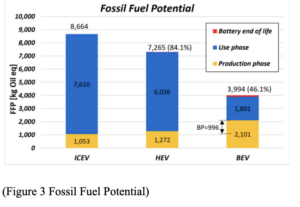
Figure 3 refernces the global warming potential related to the entire lifecycle of the three reference vehicles. In the production phase, it can be seen that the traditional vehicles will generate less FFP which is 1053 kg Oil eq. It is because the processes and manufacturing technologies have been optimized and updated over a long time. The production of batteries of HEV and BEV leads to the higher emission of CO2, but in using phase, the advantages of electric cars come in. It only generates 1801 CO2eq. However, the ICEV and HEV generate 7610 kg CO2eq and 6026 CO2eq respectively, which is around seven and six times more than EVs.
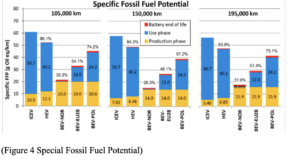
Figure 4 shows the specific fossil fuel potential (oil-eq/km) related to the 5 reference vehicles in the 3 different scenarios. It confirms that majority of EVs pollution comes from the production phase, and during the entire use phase, emissions are almost zero regardless of the distance traveled. Although conventional cars do not have the pollution generated in the battery recycling process, they account for a large proportion of the pollution in the driving process. Overall, their CO2 emissions are still much higher than EVs.
Finally, EV’s batteries can be recycled and reused, which contribute a lot to solving global warming. The lithium-ion batteries are mainly used in EV cars and most of them are manufactured in China, which is the largest producer in the word. For example, lithium-ion bases batteries for electric vehicles, in 2017 about 70% of the world production (145 out of 206 GWh) came from China (IEA,2022). Presently, the most diffused cathode chemistries for lithium-ion batteries are LCO—Lithium Cobalt Oxide (LiCoO2), LMO—Lithium Manganese Oxide (LiMn2O4), NMC—Lithium Nickel Manganese Cobalt Oxide (LiNiMnCoO2), LFP—Lithium Iron Phosphate (LiFePO4) and NCA—Lithium Nickel Cobalt Aluminum Oxide (LiNiCoAlO2) (Blomgren, G.E.,2016). In these categories of battery, graphite is the most commonly used anode material (Mathieux et al.,2017), and use all the different cathode chemistries already listed. In this different type of batteries, NMC batteries currently constitutes the most diffused technology among the electric vehicles registered in the United States, Europe, and Japan (Dai et al.,2019). The reason is because its high energy density and long cycle life.
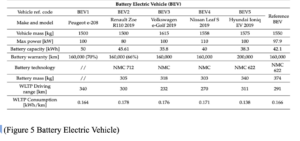
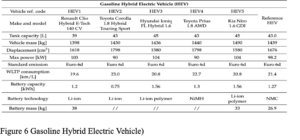
Figure 5 and 6 show a comprehensive comparison of different car models. From the comparison of HEV and BEV, we can tell that the NMC batteries have better battery capacity, less consumption, and long lifetime than other Li-ion batteries, which will be the ideal batteries for EVs to reduce the cost of production and solve for global warming. NMC batteries are increasingly used compared to LFP technology, and continued growth is expected in years to come. Concerning recycling, Pyrometallurgical processed are commonly used in Europe (Mathieux et al.,2017). The process will not recycle the graphite, plastic materials, aluminum and lithium. However, the last three elements will be retained in the slag (Dunn et al.,2012). The metal alloy and slag obtained from the pyrometallurgical process can be further refined through the hydrometallurgical process. Through this process, the metal sulphates can be recycled and be used again to produce the cathode of lithium-ion batteries (Anonymous, 2020). With this battery recycling
process, the energy and pollution needed to produce batteries could be greatly reduced, making EVs more advantageous to combat global warming.
Rebuttal
Althrough EVs are not always ideal vehicles to deal with the global warming since there are lots of pollution generated during the battery production process. It is true that EV will generate air pollution, particulate pollution as well as causing the soil acidification. However, compared with traditional cars, due to its long-term technology accumulation and progress, EV generates more pollution than traditional cars in the production process. However, for the EVs, it’s only been widely used in recent years, so some production techniques are not perfect, but we cannot just look at the production process. Through the whole entire lifecycle, from production to recycle and the final phase of waste disposal, EVs still generate less CO2 and GWP which is the main reason of the global warming. And with the continuous progress of technology, the battery of electric vehicles is also constantly optimized. Now the NMC batteries have high density and long lifecycle, which will reduce the pollution generated by the production of electric vehicles.
Conclusion
Evidence shows that the electric vehicles are a good solution to global pollution, although we cannot absolutely say that electric cars are completely zero emission. After all, there will be some pollution in the process of producing cars. Besides, due to technological limitations, zero pollution cannot be completely achieved in the process of
producing electricity. However, electric cars are environmentally friendly compared to other cars. To be more specific, promoting the use of EV is the best solution to environmental problems so far. PM2.5 and GHG emissions per EV throughout its whole lifetime is 43% lower than those of a similar gasoline-fueled vehicle, making it the most environmentally friendly transportation. With scholars forecasting that in 2050, every second car on the streets could be electric. This could solve people’s living environment pollution problems. This would as reduce global warming sharply with the great decrease in total carbon dioxide emission and a significant portion of fossil-fuel use will be replaced by sustainable energy. To sum up, electric cars are indeed a good solution to environmental problems.
Reference
European Environmental Agency (2021). EMEP/EEA Air Pollutant Emission Inventory Guidebook 2019. https://www.eea.europa.eu/publications/emep-eea-guidebook-2019
Ghosh, A. (2020). Possibilities and Challenges for the Inclusion of the Electric Vehicle (EV) to Reduce the Carbon Footprint in the Transport Sector: A Review. Energies, 13(10), 14. https://doi.org/10.3390/en13102602.
Usai, L., Hung, C.R., Vásquez, F., Windsheimer, M., Burheim, O.S., Strømman,A.H. (2018).Life cycle assessment of fuel cell systems for light duty vehicles. Journal of Cleaner Production. https://doi.org/10.1016/j.jclepro.2020.125086
IEA (2019). Transport sector CO2 emissions by mode in the Sustainable Development Scenario. https://www.iea.org/data-and-statistics/charts/transport-sector-co2-emissions-by-mode-in-the-sustainable-development-scenario-2000-20
Marco Raugei, Allan Hutchinson, Denise Morrey (2018) Can electric vehicles significantly reduce our dependence on non-renewable energy? Scenarios of compact vehicles in the UK as a case in point. Journal of Cleaner Production,280(2). https://doi.org/10.1016/j.jclepro.2018.08.107
IEA. (2022) Commissioned EV and Energy Storage Lithium-Ion Battery Cell Production Capacity by Region and Associated Annual Investment. https://www.iea.org/data-and-statistics/charts/commissioned-ev-and-energystorage-lithium-ion-battery-cell-production-capacity-by-region-and-associated-annual-investment-2010-2022
HAUSCHILD, M., GOEDKOOP, M., GUINEE, J., HEIJUNGS, R., HUIJBREGTS, M., JOLLIET, O., MARGNI, M., & DE SCHRYVER, A. (2012). Recommendations for life cycle impact assessment in the European context – based on existing environmental impact assessment models AND FACTORS (international reference life cycle data system – ILCD handbook). JRC Publications Repository. https://publications.jrc.ec.europa.eu/repository/handle/JRC61049
Ellingsen, L.A.-W.; Majeau-Bettez, G.; Singh, B.; Srivastava, A.K.; Valøen, L.O.; Strømman, A.H(2022). Life cycle assessment of a lithium-ion battery vehicle pack. Wiley Online Library. https://onlinelibrary.wiley.com/doi/10.1111/jiec.12072
Blomgren, G. E. (2016). The Development and Future of Lithium-Ion Batteries. Journal of The Electrochemical Society. https://iopscience.iop.org/article/10.1149/2.0251701jes.
Mathieux, F., Ardente, F., Bobba, S., Nuss, P., Blengini, G., Alves Dias, P., Blagoeva, D., Torres De Matos, C., Wittmer, D., Pavel, C., Hamor, T., Saveyn, H., Gawlik, B., Orveillon, G., Huygens, D., Garbarino, E., Tzimas, E., Bouraoui, F. and Solar, S., Critical Raw Materials and the Circular Economy – Background report, EUR 28832 EN, Publications Office of the European Union, Luxembourg, 2017, ISBN
978-92-79-74283-5 (print),978-92-79-74282-8 (pdf), doi:10.2760/378123 (online),10.2760/977855 (print), JRC108710.
Groth, C. (2007). A New-Growth Perspective on Non-Renewable Resources. The Economics of Non-Market Goods and Resources. https://doi.org/10.1007/978-1-4020-6293-3_7
The Advanced Rechargeable & Lithium Batteries Association PEFCR—Product Environmental Footprint Category Rules for High Specific Energy Rechargeable Batteries for Mobile Applications Version (31 December 2020): Retrieved May 7, 2022, from https://ec.europa.eu/environment/eussd/smgp/pdf/PEFCR_Batteries.pdf.
Dunn, J B, Gaines, L, Barnes, M, Wang, M, & Sullivan, J. (2012). Material and energy flows in the materials production, assembly, and end-of-life stages of the automotive lithium-ion battery life cycle. United States. https://doi.org/10.2172/1044525.
Dai, Q.; Kelly, J.C.; Gaines, L.; Wang, M. (2019) Life Cycle Analysis of Lithium-Ion Batteries for Automotive Applications. Batteries 2019. https://www.mdpi.com/2313-0105/5/2/48
Pipitone, E.; Caltabellotta, S.; Occhipinti, L. (2021) A Life Cycle Environmental Impact Comparison between Traditional, Hybrid, and Electric Vehicles in the European Context.Sustainability 2021. https://doi.org/10.3390/su131910992
